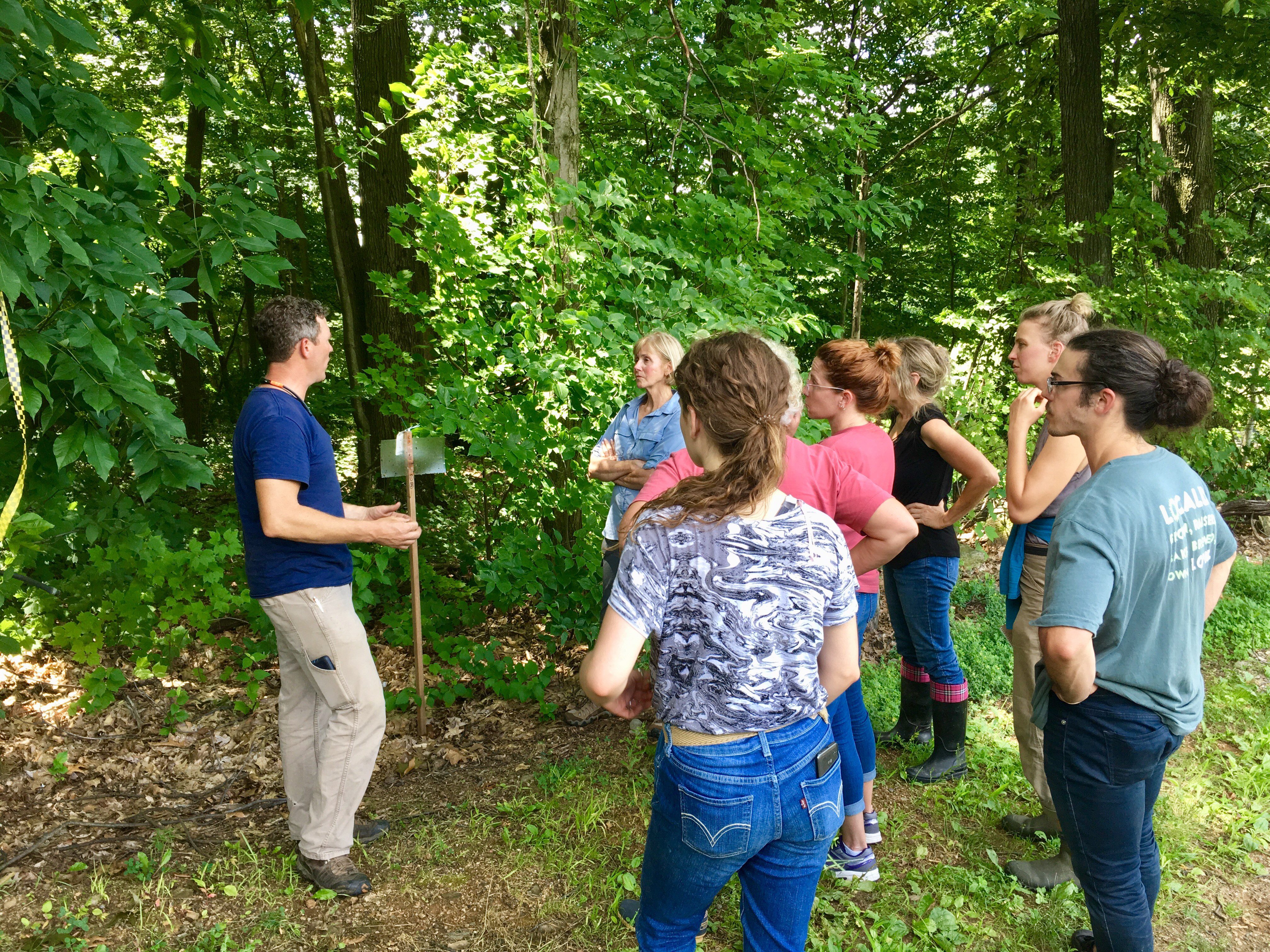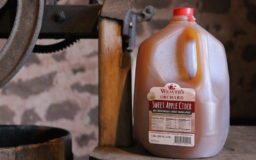We’re all familiar with the difference between a Certified Organic product and a “conventional”, or non-organic one. But do you know what it means when produce is labeled “IPM”? It turns out, there is a whole lot to learn on this topic – and the more you learn, the more you realize just how complicated of a business it is to grow food. That’s why we sought out a trusted expert, Steve Frecon of Frecon Farms, to shed some light. He’s the third generation of a family-owned tree fruit farm, and he took the time to explain to us what it means to grow using IPM practices.

The Kimberton Whole Foods team learns about IPM practices from Steve Frecon.
WHAT IS IPM?
Integrated Pest Management (IPM) is based on careful monitoring, prevention, and cautious treatment of problems as they arise. It is a process farmers use to solve pest problems while minimizing risks to people and the environment. IPM focuses on long-term prevention of pests and their damage by managing the farm’s ecosystem through biological, cultural, mechanical and (as a last resort) chemical controls. Many times IPM produce is grown without the use of chemical pesticides, but when a farmer determines that chemical intervention is required, he or she will use care in applying the most selective pesticide that will do the job while being safest to other organisms, air, soil, and water quality.
Unlike organic farming, there is no certifying body for IPM, which makes it all the more complicated to understand. It also means that placing trust in local farmers with whom you have good relationships is the best way to have peace of mind about what is in, or on, your food. As always, we find that transparency is key for us and for our customers to make informed decisions about their purchases.
THE CHALLENGES
First, let’s consider some of the challenges that Pennsylvania farmers (particularly fruit growers) are up against: Weather and pests are at the top of this list. Here, growers combat moisture – this is a problem that farmers face from Michigan to Florida. Moisture (humidity) means insects, disease, and fungi can run rampant. As a stark contrast, this humidity is not an issue in the deserts of California, where the majority of our country’s fruit is grown.
Where pests are concerned, Steve Frecon shared that most of the pests we are dealing with are not originally from North America at all – but then again neither are apples, as he reminded us. This means that they may run unchecked, without as many native predators. Many of the worst pests that farmers face today came to the United States through various trades and consumer goods, including stone and produce. Pests that affect Frecon Farms and other growers of tree fruit include San Jose Scale, Spotted Lanternfly, Brown Marmorated Stink Bug, Oriental Fruit Moth, European Red Mites, and Emerald Ash Borer, to name a few.
Releasing beneficial predator bugs may be one of the precautions that modern farmers take to protect their crop. However, even this solution is not without extensive work and investment. Beneficial insects must be provided with a habitat in the form of native plants, which the farmer must then tend to, in addition to the crop they are trying to grow! The matter of managing pests is complex and requires trial and error on the part of our farmers.

CAREFUL TRACKING
Tracking insects and pests is a huge part of the monitoring practices used in IPM. Many growers work with local entomologists to track bugs and populations, which can give them valuable insight into the future health of their crop. Steve explained that when he’s keeping track, he may not be concerned with seeing 2-3 mites on a leaf. He wouldn’t spray or take any action. He asks himself “Do we have a problem? Can I let this one ride a bit longer?” Yet when he starts seeing 6, 7, 8, 9 trees affected – then he needs to treat that block. Otherwise, these things will eventually affect the health of the trees and the size of the fruit they produce.
HORMONAL CONTROLS
By carefully tracking pests, farmers can make strategic use of hormonal controls, as well. Steve shares, “We use pheromone traps to monitor insect populations and pheromone lures to reduce certain insect populations to non-threatening levels. Tiny little bands are placed on trees that are baited with particular pests’ pheromones and result in mating pairs never finding each other to produce new generations. Nothing is sprayed, no fuel is expended and there is no residual effect in the environment.”
DO YOU SPRAY?
Steve shares that the first question he gets when speaking to consumers is “do you spray?”. He wants to dispel the myth that organic farmers do not spray: Spraying is a method all farmers use to deliver nutrition and pesticides (organic and synthetic) to the plants they manage. Organic growers simply spray materials approved for use in the USDA Organic program: non-synthetic chemicals. He goes on to share that there are so many aspects to why and how a farmer may spray. “There’s a lot more to IPM than can be explained at a farmers market!” he jokes.
Steve relies on many OMRI approved chemicals, which are approved for use in organic agriculture and would be used by a Certified Organic grower in their management program. He believes in using them if they are the right tool for the job with the least negative effects. For example, he showed us Cueva (copper octanoate), a liquid copper fungicide he uses to combat apple scab, fire blight, and bacterial spot – diseases affecting apple, peach, and pear trees. He explains how he could go out and spray an entire block of trees with streptomycin (a synthetic control agent) to prevent the blight, but “We make the choice not to do that unless monitoring deems the threshold for these diseases is higher then can be managed with Cueva. That’s what IPM is all about.” Steve is especially interested in new “biologicals” as an alternative to more traditional treatments.
The growers of fruit trees also face a unique challenge: Unlike a farmer of annuals, such as tomatoes, blight must be treated before it leads to the destruction of an entire orchard. A bad year means the loss of many years of work and planning. (Apple growers typically plan for a block 5 years in advance by pre-ordering their rootstock and supplies, then it takes 3-10 years of planning, shaping, and pruning to get a good, producing tree, and then that tree should have a life of 25 years.) We could understand how Steve has a lot to lose if he does not manage the risks involved with the spread of disease, fungus, and pests in his orchard.
For those who would question how much he does (or would) spray, he says “look around, look at the biology”. We saw fields full of weeds, and plenty of bugs. Plenty of spots, blight, etc. This tells us that he is not blanket-spraying to prevent these things – they are present.
LOCAL IPM, OR NON-LOCAL ORGANIC?
When weighing the difference between purchasing a certified organic apple shipped from across the country, or a local IPM apple shipped from just miles away, Steve says, “Each comes with its own cost.” Read more about his views on the importance of buying, selling, and eating locally, here.
“When I was a kid we were competing with California”, Steve explained. He shared how the local food movement has made it possible for him to continue in this business on the East Coast, as a third-generation farmer. What can we do to support the safe growing practices and livelihoods of our local farmers? “Buy local products! Customers must “choose to buy a local apple over a cheaper Washington State apple,” says Steve.
We agree! That’s why you can look for locally-grown, IPM fruit at your nearest Kimberton Whole Foods.






